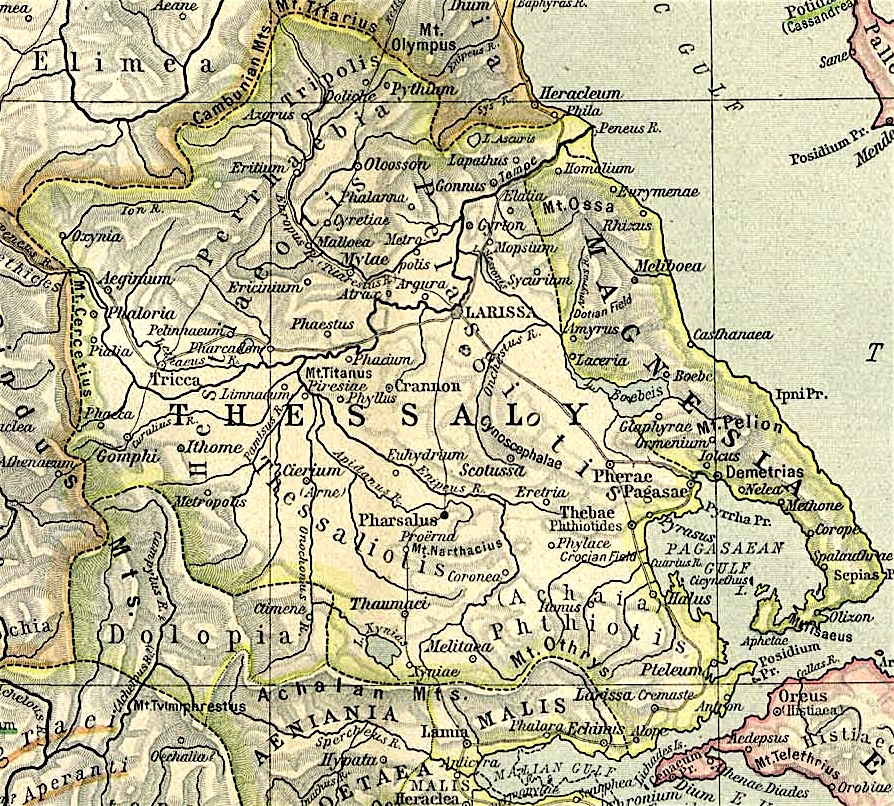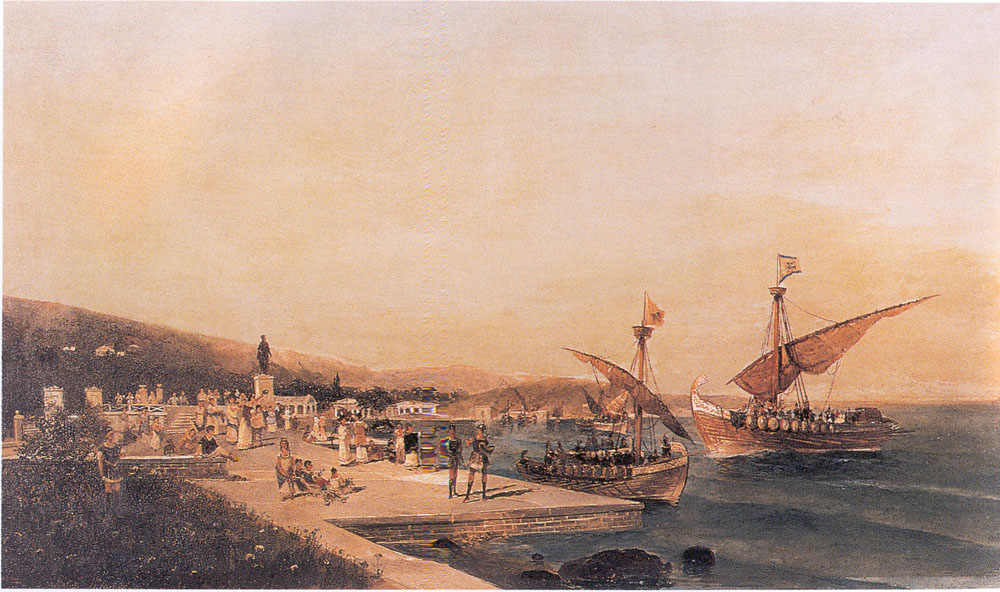|
Dimini
Dimini ( el, Διμήνι; older form: ''Diminion'') is a village near the city of Volos, in Thessaly (central Greece), in Magnesia. It was the seat of the municipality of Aisonia. The name Aisonia dates back to ancient times and it is the westernmost place in the Volos area. The Dimini area contains both a Mycenean settlement and a Neolithic settlement. The Neolithic settlement in Dimini was discovered near the end of the 19th century and was first excavated by the archaeologists Christos Tsountas and Valerios Stais. The palace of ancient Iolcos is believed to be located in modern-day Dimini, where a Mycenaean palace was excavated recently. Population History Neolithic Dimini culture is well known for its abstract painted vessels. Dimini ware is characteristic of the Later Neolithic period in eastern Thessaly, although it was traded and imitated outside the region and has been identified as far away as Cakran in Albania. File:Clay vase with polychrome decoration, D ... [...More Info...] [...Related Items...] OR: [Wikipedia] [Google] [Baidu] |
Sesklo And Dimini Fortifications
Sesklo and Dimini are two of the main sites of the Greek Neolithic Period, ca. 6000-3000 BCE. They are located only a few miles apart in the Thessaly region of Greece and were excavated between 1899 and 1906 by Christos Tsountas. Both settlements included a large central megaron building surrounded by smaller buildings and houses, as well as enclosing walls. The purpose of these walls has long been debated, with Tsountas initially claiming that they had defensive military purposes. However, over time more and more archaeologists have concluded that they instead functioned as retaining walls, to mark habitation spaces, as animal enclosures, or were used for ritual purposes. Regardless of their intended purpose, the fortifications reinforced the distinction between the inner settlement and outside world. Site locations Sesklo The Sesklo ( el, Σέσκλο) settlement consists of three main phases. In general, there were close houses centered around a larger megaron with a paved ... [...More Info...] [...Related Items...] OR: [Wikipedia] [Google] [Baidu] |
Neolithic Greece
Neolithic Greece is an archaeological term used to refer to the Neolithic phase of Greek history beginning with the spread of farming to Greece in 7000–6500 BC. During this period, many developments occurred such as the establishment and expansion of a mixed farming and stock-rearing economy, architectural innovations (i.e. "megaron-type" and "Tsangli-type" houses), as well as elaborate art and tool manufacturing. Neolithic Greece is part of the Prehistory of Southeastern Europe. Periodization The Neolithic Revolution reached Europe beginning in 7000–6500 BC, during the Pre-Pottery Neolithic B period, when agriculturalists from the Near East entered the Greek peninsula from Anatolia mainly by island-hopping through the Aegean Sea. Modern archaeologists have divided the Neolithic period of Greek history into six phases: Pre-Pottery, Early Neolithic, Middle Neolithic, Late Neolithic I, Late Neolithic II and Final Neolithic (or Chalcolithic). Sites of Neolithic Greece These a ... [...More Info...] [...Related Items...] OR: [Wikipedia] [Google] [Baidu] |
Sesklo Culture
Sesklo ( el, Σέσκλο; rup, Seshklu) is a village in Greece that is located near Volos, a city located within the municipality of Aisonia. The municipality is located within the regional unit of Magnesia that is located within the administrative region of Thessaly. During the prehistory of Southeastern Europe, Sesklo was a significant settlement of Neolithic Greece, before the advent of the Bronze Age and millennia before the Mycenaean period. Sesklo culture The settlement at Sesklo gives its name to the earliest known Neolithic culture of Europe, which inhabited Thessaly and parts of Macedonia. The Neolithic settlement was discovered in the 19th century and the first excavations were made by the Greek archaeologist, Christos Tsountas. Pre-Sesklo The oldest fragments researched at Sesklo place development of the culture as far back as c. 7510 BC — c. 6190 BC, known as proto-Sesklo and pre-Sesklo. They show an advanced agriculture and a very early use of pottery that ... [...More Info...] [...Related Items...] OR: [Wikipedia] [Google] [Baidu] |
Old Europe (archaeology)
Old Europe is a term coined by the Lithuanian archaeologist Marija Gimbutas to describe what she perceived as a relatively homogeneous pre-Indo-European Neolithic and Copper Age cultural horizon or civilisation in Southeastern Europe and part of Central-Eastern Europe, centred in the Danube River valley. Old Europe is also referred to in some literature as the Danube civilisation. The term ' Danubian culture' was earlier coined by the archaeologist Vere Gordon Childe to describe early farming cultures (e.g. the Linear Pottery culture) which spread westwards and northwards from the Danube valley into Central and Eastern Europe. Old Europe Old Europe, or Neolithic Europe, refers to the time between the Mesolithic and Bronze Age periods in Europe, roughly from 7000 BCE (the approximate time of the first farming societies in Greece) to c. 2000 BCE (the beginning of the Bronze Age in Scandinavia). The duration of the Neolithic varies from place to place: in Southeastern Europ ... [...More Info...] [...Related Items...] OR: [Wikipedia] [Google] [Baidu] |
Aisonia
Aisonia ( el, Αισωνία) is a former municipality in Magnesia, Thessaly, Greece. Since the 2011 local government reform it is part of the municipality Volos, of which it is a municipal unit. The municipal unit has an area of 75.504 km2. Population 3,249 (2011). The seat of the municipality was in Dimini. Subdivisions The municipal unit Aisonia is subdivided into the following communities (constituent villages in brackets): *Dimini (Dimini, Kakkavos, Paliouri) *Sesklo Sesklo ( el, Σέσκλο; rup, Seshklu) is a village in Greece that is located near Volos, a city located within the municipality of Aisonia. The municipality is located within the regional unit of Magnesia that is located within the adminis ... (Sesklo, Chrysi Akti Panagias) Population References External links Aisonia on GTP Travel Pages Populated places in Magnesia (regional unit) {{Thessaly-geo-stub ... [...More Info...] [...Related Items...] OR: [Wikipedia] [Google] [Baidu] |
Thessaly
Thessaly ( el, Θεσσαλία, translit=Thessalía, ; ancient Thessalian: , ) is a traditional geographic and modern administrative region of Greece, comprising most of the ancient region of the same name. Before the Greek Dark Ages, Thessaly was known as Aeolia (, ), and appears thus in Homer's '' Odyssey''. Thessaly became part of the modern Greek state in 1881, after four and a half centuries of Ottoman rule. Since 1987 it has formed one of the country's 13 regions and is further (since the Kallikratis reform of 2011) sub-divided into five regional units and 25 municipalities. The capital of the region is Larissa. Thessaly lies in northern Greece and borders the regions of Macedonia on the north, Epirus on the west, Central Greece on the south, and the Aegean Sea on the east. The Thessaly region also includes the Sporades islands. Name and etymology Thessaly is named after the ''Thessaloi'', an ancient Greek tribe. The meaning of the name of this tribe is ... [...More Info...] [...Related Items...] OR: [Wikipedia] [Google] [Baidu] |
Volos
Volos ( el, Βόλος ) is a coastal port city in Thessaly situated midway on the Greek mainland, about north of Athens and south of Thessaloniki. It is the sixth most populous city of Greece, and the capital of the Magnesia regional unit of the Thessaly Region. Volos is also the only outlet to the sea from Thessaly, the country's largest agricultural region. With a population of 144,449 (2011), the city is an important industrial centre, and its port provides a bridge between Europe and Asia. Volos is the newest of the Greek port cities, with a large proportion of modern buildings erected following catastrophic earthquakes in 1955. It includes the municipal units of Volos, Nea Ionia and Iolkos, as well as smaller suburban communities. The economy of the city is based on manufacturing, trade, services and tourism. Home to the University of Thessaly, the city also offers facilities for conferences, exhibitions and major sporting, cultural and scientific events. Volos par ... [...More Info...] [...Related Items...] OR: [Wikipedia] [Google] [Baidu] |
Neolithic Europe
The European Neolithic is the period when Neolithic (New Stone Age) technology was present in Europe, roughly between 7000 BCE (the approximate time of the first farming societies in Greece) and c.2000–1700 BCE (the beginning of the Bronze Age in Scandinavia). The Neolithic overlaps the Mesolithic and Bronze Age periods in Europe as cultural changes moved from the southeast to northwest at about 1 km/year – this is called the Neolithic Expansion. The duration of the Neolithic varies from place to place, its end marked by the introduction of bronze tools: in southeast Europe it is approximately 4,000 years (i.e. 7000 BCE–3000 BCE) while in parts of Northwest Europe it is just under 3,000 years (c. 4500 BCE–1700 BCE). In parts of Europe, notably the Balkans, the period after c. 5000 BC is known as the Chalcolithic (Copper Age), due to the invention of copper smelting and the prevalence of copper tools, weapons and other artefacts. The spread of the Neolithic from the ... [...More Info...] [...Related Items...] OR: [Wikipedia] [Google] [Baidu] |
Linear B
Linear B was a syllabic script used for writing in Mycenaean Greek, the earliest attested form of Greek. The script predates the Greek alphabet by several centuries. The oldest Mycenaean writing dates to about 1400 BC. It is descended from the older Linear A, an undeciphered earlier script used for writing the Minoan language, as is the later Cypriot syllabary, which also recorded Greek. Linear B, found mainly in the palace archives at Knossos, Kydonia, Pylos, Thebes and Mycenae, disappeared with the fall of Mycenaean civilization during the Late Bronze Age collapse. The succeeding period, known as the Greek Dark Ages, provides no evidence of the use of writing. Linear B, deciphered by English architect and self-taught linguist Michael Ventris—based on the research of American classicist Alice Kober—is the only Bronze Age Aegean script to have been deciphered. Linear B consists of around 87 syllabic signs and over 100 ideographic signs. These ideograms or "signifying" ... [...More Info...] [...Related Items...] OR: [Wikipedia] [Google] [Baidu] |
National Archaeological Museum, Athens
The National Archaeological Museum ( el, Εθνικό Αρχαιολογικό Μουσείο) in Athens houses some of the most important artifacts from a variety of archaeological locations around Greece from prehistory to late antiquity. It is considered one of the greatest museums in the world and contains the richest collection of Greek Antiquity artifacts worldwide. It is situated in the Exarcheia area in central Athens between Epirus Street, Bouboulinas Street and Tositsas Street while its entrance is on the Patission Street adjacent to the historical building of the Athens Polytechnic university. History The first national archaeological museum in Greece was established by the governor of Greece Ioannis Kapodistrias in Aigina in 1829. Subsequently, the archaeological collection was relocated to a number of exhibition places until 1858, when an international architectural competition was announced for the location and the architectural design of the new museum.The Nat ... [...More Info...] [...Related Items...] OR: [Wikipedia] [Google] [Baidu] |






